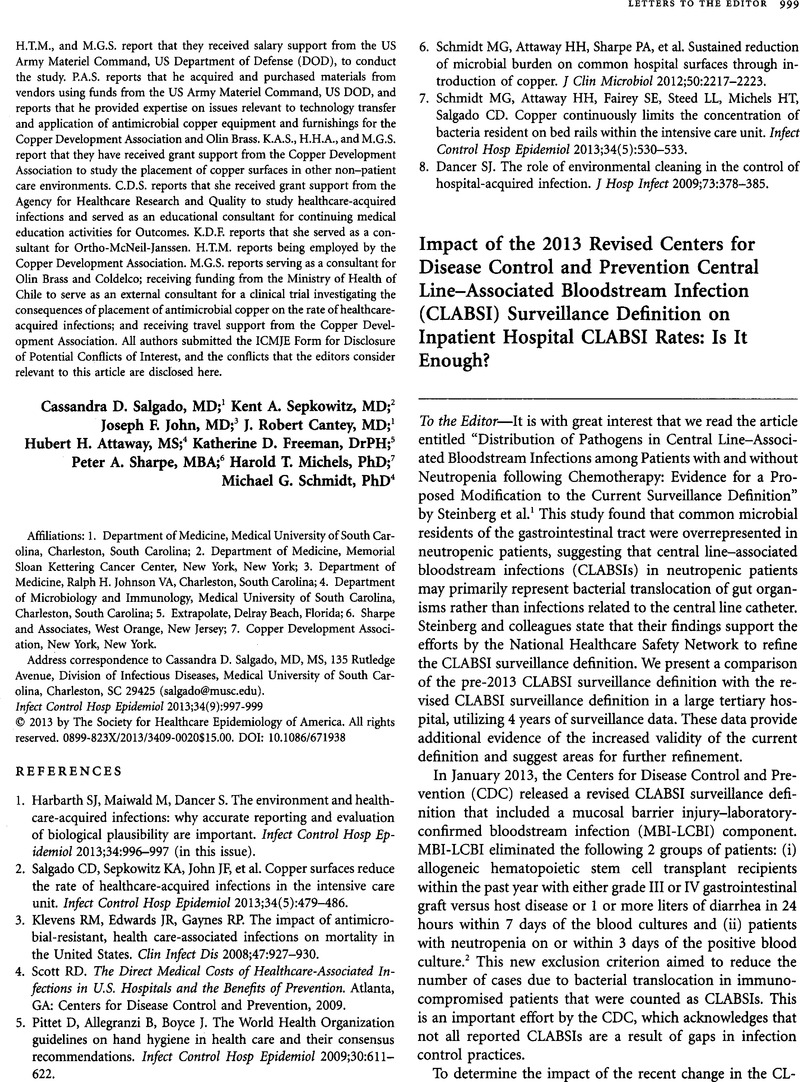Crossref Citations
This article has been cited by the following publications. This list is generated based on data provided by Crossref.
Åttman, Emilia
Aittoniemi, Janne
Sinisalo, Marjatta
Vuento, Risto
Lyytikäinen, Outi
Kärki, Tommi
Syrjänen, Jaana
and
Huttunen, Reetta
2015.
Etiology, clinical course and outcome of healthcare-associated bloodstream infections in patients with hematological malignancies: a retrospective study of 350 patients in a Finnish tertiary care hospital.
Leukemia & Lymphoma,
Vol. 56,
Issue. 12,
p.
3370.
Rhee, Yoona
Heung, Michael
Chen, Benrong
and
Chenoweth, Carol E.
2015.
Central Line-Associated Bloodstream Infections in Non-ICU Inpatient Wards: A 2-Year Analysis.
Infection Control & Hospital Epidemiology,
Vol. 36,
Issue. 4,
p.
424.
Chen, Xihn-Xuh
Lo, Yi-Chu
Su, Lin-Hui
and
Chang, Chin-Lu
2015.
Investigation of the case numbers of catheter-related bloodstream infection overestimated by the central line-associated bloodstream infection surveillance definition.
Journal of Microbiology, Immunology and Infection,
Vol. 48,
Issue. 6,
p.
625.
Zakhour, Ramia
Chaftari, Anne-Marie
and
Raad, Issam I
2016.
Catheter-related infections in patients with haematological malignancies: novel preventive and therapeutic strategies.
The Lancet Infectious Diseases,
Vol. 16,
Issue. 11,
p.
e241.
Choksi, Ankur
Finnegan, Karen
and
Etezadi, Vahid
2020.
Does systemic antibiotic prophylaxis prior to the placement of totally implantable venous access devices reduce early infection? A retrospective study of 1,485 cases at a large academic institution.
American Journal of Infection Control,
Vol. 48,
Issue. 1,
p.
95.
Böll, Boris
Schalk, Enrico
Buchheidt, Dieter
Hasenkamp, Justin
Kiehl, Michael
Kiderlen, Til Ramon
Kochanek, Matthias
Koldehoff, Michael
Kostrewa, Philippe
Claßen, Annika Y.
Mellinghoff, Sibylle C.
Metzner, Bernd
Penack, Olaf
Ruhnke, Markus
Vehreschild, Maria J. G. T.
Weissinger, Florian
Wolf, Hans-Heinrich
Karthaus, Meinolf
and
Hentrich, Marcus
2021.
Central venous catheter–related infections in hematology and oncology: 2020 updated guidelines on diagnosis, management, and prevention by the Infectious Diseases Working Party (AGIHO) of the German Society of Hematology and Medical Oncology (DGHO).
Annals of Hematology,
Vol. 100,
Issue. 1,
p.
239.
Gao, Tianqi
Zhu, Xiangding
Zeng, Qingli
Li, Xiaozhen
Luo, Man
Yu, Changhui
Hu, Liwen
He, Jing
Li, Yaohe
Yang, Zhiwen
Yang, Huifang
Huang, Xiaohua
Gu, Xuekui
and
Liu, Zenghui
2022.
Peripherally inserted central catheter-related bloodstream infections in patients with hematological malignancies: A retrospective 7-years single-center study.
American Journal of Infection Control,
Vol. 50,
Issue. 10,
p.
1171.



